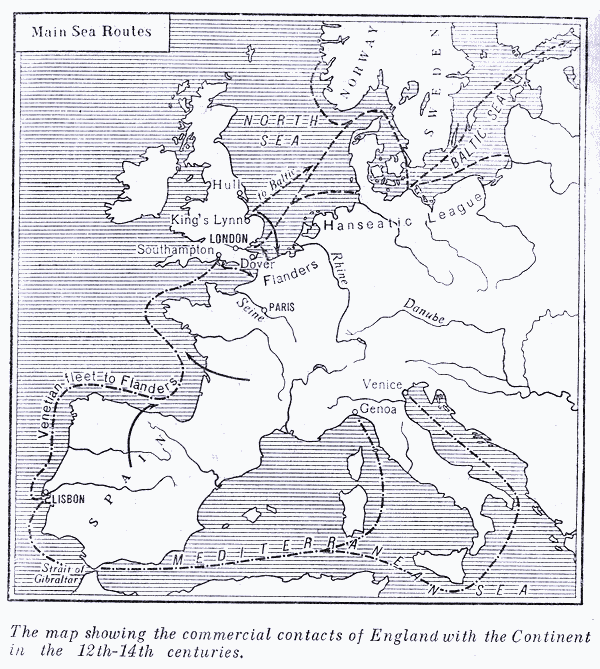Main Sea Routes
Category: 12th centuryLondon merchants drew great incomes from the wool trade, as the capital was a centre of trade for Northern Europe. It established commercial contacts with the trading towns of the Mediterranean which was a link in the trade between Western Europe and the eastern countries. After the crusades began, people learned more about the products of the East, and trade with the oriental countries grew rapidly. First the English merchants brought their goods to the mouth of the Rhine, which was the main highway for trade between the Mediterranean and the North. At the end of the 12th century England established direct and permanent connections with the north Italian towns of Venice and Genoa which dominated over the Mediterranean Sea.
Every year a fleet of Venetian galleys laden with spices and silks of the East, sailed from Venice through the Strait of Gibraltar and up to the English Channel to Flanders. On their way the Venetian ships called at ports on the southern coast of England, and much buying and selling went on. English merchants bought oriental articles of luxury and sold them again at a high profit to the feudal lords and rich townspeople. The trade in spices was particularly profitable. Spices were weighed out very carefully and sold in small quantities at enormous prices. Often they cost their weight in gold.
An important sea route ran across the North Sea and the Baltic. England carried on a brisk trade with the Baltic and Scandinavian countries. The towns situated on the banks of navigable rivers or close to sea harbours increased their trade rapidly. Apart from London a lively trade across the Channel from the ports of the southern coast to Flanders and the Baltic grew up.
Hull, Boston, Dover, Newcastle, Southampton, Ipswich, King’s Lynn had become important trade centres already in the 12th century. The merchants of the Hanseatic League which consisted of a number of German towns settled in London, Hull and other English ports. They carried on much of the trade between England and the countries of Northern Europe. There were also settlements of merchants from Flanders and from the Baltic.
Closer contact with the continent of Europe made more articles available for exchange. The list of imports was considerably increased: from France — wine, salt and building stone for castles and churches; a greater quantity and variety of fine cloths and spices from the East. Besides wool, England exported tin, lead, cattle. At first the bulk of the export trade was in the hands of Italian and Flemish merchants. With the growth of trade at the end of the 13th century more than half the trade was in the hands of English merchants.
The close link between England and countries of the Continent meant more coming and going across the Channel of people exchanging not only goods but ideas as well. Through commercial contacts the English could learn more about the economic and cultural achievements of other countries.

